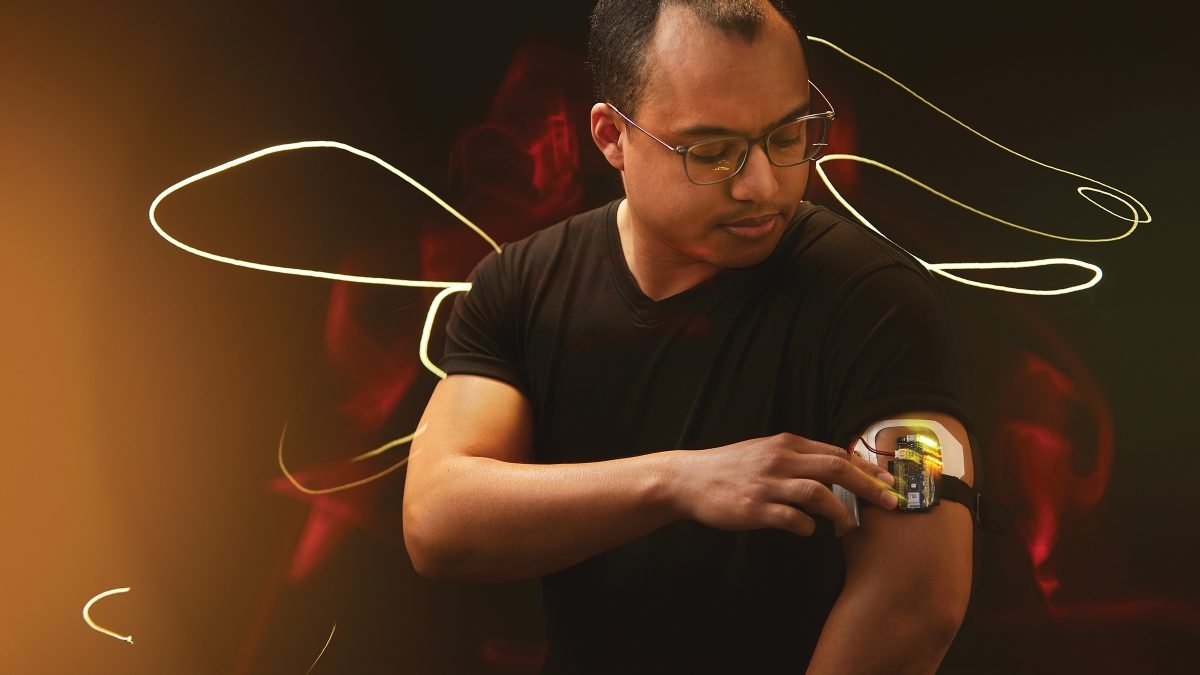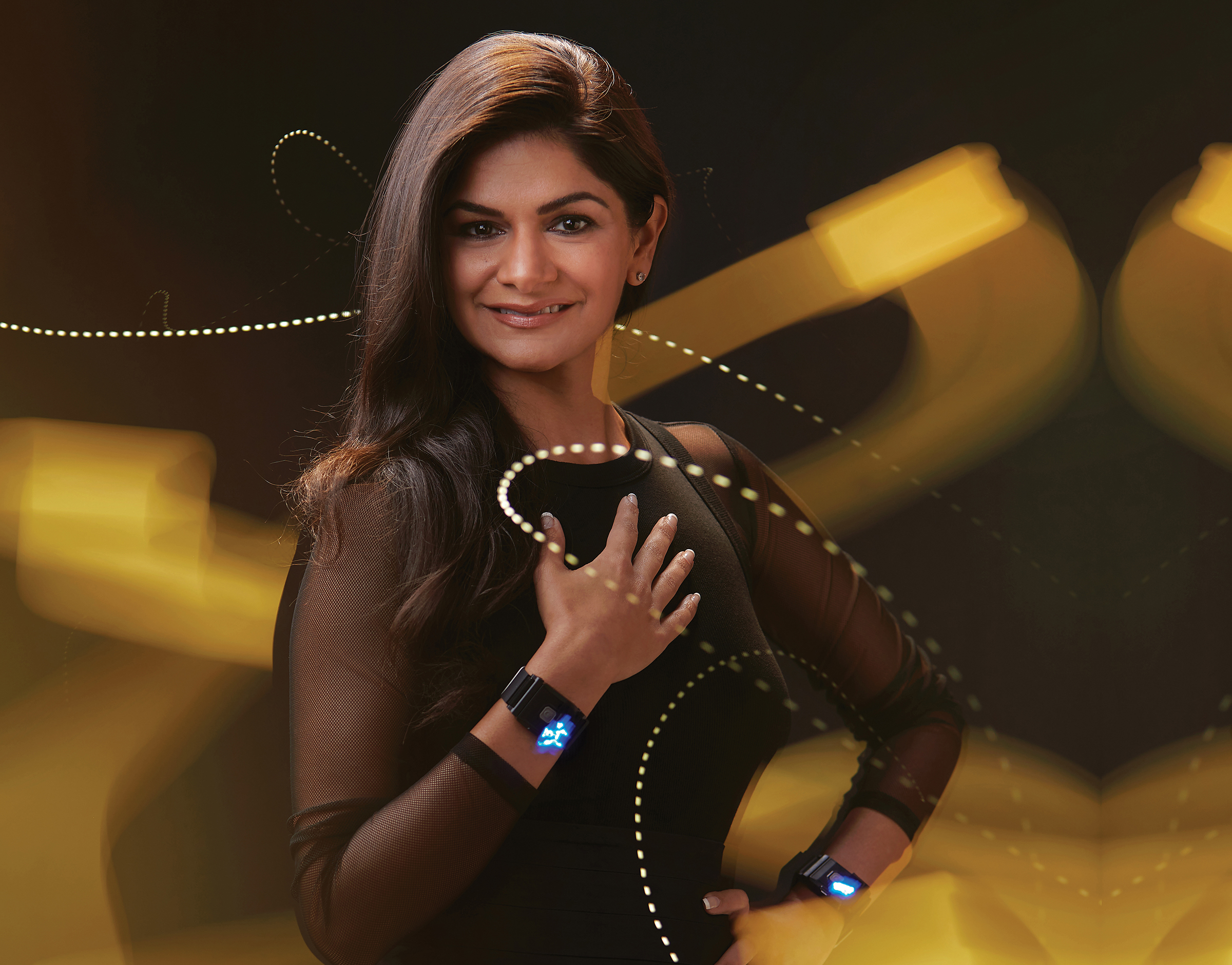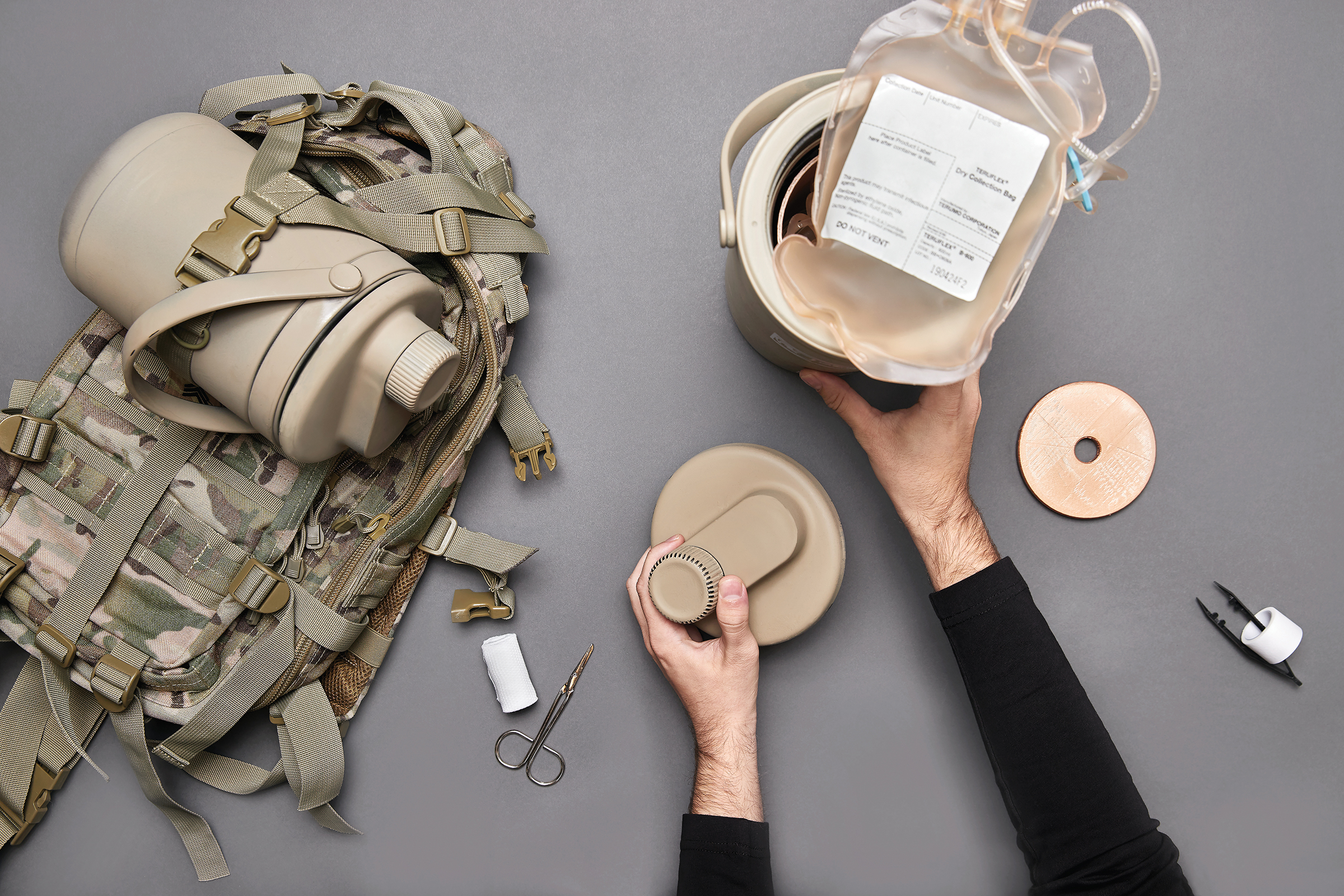It’s a feeling familiar to us all. We sense it when we’re waiting for the results of a medical exam, preparing to ask our boss for a raise, or rehearsing to ask our crush on a date. It’s called stress, and it’s the body’s natural reaction to a tense, uncertain situation.
Nick Hool, a current graduate student in engineering who in 2016 completed his BSE in bioengineering, knows all about it. Hool has been an avid golfer for most of his life, but he still feels the rush of nerves when he steps onto the green to tee off. But after years of research, he believes he may finally have a solution — no pills or weeklong meditation retreats required.
Hool’s solution, developed with two other ASU engineering students, is a small pair of earbuds he calls the P57 ONE. Instead of piping in music, the earbuds deliver a weak electric current to the inner ear to stimulate the nerve that regulates our fight-or-flight response. As Hool discovered, the earbuds produce a rapid decline in the wearer’s stress levels, which he hopes may one day include professional athletes, soldiers and anyone who wants to bring a little more calm to their life.
Hool is currently conducting clinical trials under the auspices of his company, Hoolest Technologies, which got a big boost when it won $100,000 in the ASU Innovation Open in 2018. Hoolest is one of the first to take up residence at the new WearTech Applied Research Center, which is plotting the future of wearable technology at Park Central in midtown Phoenix.
A collaboration between the Partnership for Economic Innovation and the Ira A. Fulton Schools of Engineering, WearTech opened its doors last September to ASU students, faculty and local companies. ASU has long been in the forefront of medical technology, and the center aims to accelerate the transition of these technologies from the lab to the market by forging links between industry and academia.
“We’ve come to a point in time where you can take the rich functionality of microelectronics and put it in new forms, fits and functions,” says Gregory Raupp, a professor of chemical engineering and research director of the WearTech Applied Research Center. “It’s as simple as putting on your clothes to adapt to this new technology.”
Wearable tech goes mainstream
Until a few years ago, wearable tech was rarely seen outside a lab or a clinic, where doctors used the devices to gather critical patient data or help with recovery. Some of these devices tracked the mundane ebb and flow of brain waves or glucose levels. Others, like the sophisticated robotic exoskeletons developed by Tom Sugar, a professor of engineering, had more esoteric medical applications like helping the recovery of stroke victims. These technologies improved countless lives, but it took the arrival of wearables like the Apple Watch and Fitbit to truly catapult wearable tech into the mainstream.
Not only could these consumer devices monitor various vital statistics like sleep patterns and heart rhythms, they were fashionable and affordable to boot. People became obsessed with tracking their health, and the so-called “quantified self” movement was born. Consumer wearables quickly grew beyond mere tracking technology, and devices for a host of therapeutic and performance-enhancing uses began to hit the market. Today, wearable tech is estimated by industry analyst CCS Insight to be a $25 billion global industry expected to double in size within five years.
TouchPoint Solution CEO and co-founder Vicki Mayo wears the company’s device that helps users cope with stress; it was named best in health and wellness at the 2019 Consumer Electronics Show.Photo illustration by Jeff Newton
Taking wearables from the lab to the market
With the WearTech Applied Research Center joint venture, ASU is helping to ensure that Phoenix is at the forefront of the wearables revolution. The center provides a space for Sun Devils and local industry partners working on wearables to host meetings and do testing as they prepare their products for the market. Raupp and his colleagues at WearTech also help the center’s partners navigate the legal hurdles associated with launching new medical devices, and the team helps industry partners find novel commercial applications for their technologies.
Some of the tenants, like Hool, are relative newcomers to wearable tech. Others, like Jennifer Blain Christen, an assistant professor in the School of Electrical, Computer and Energy Engineering, have been researching digital health technology for decades. In 2016, Christen, along with Mayo Clinic medical oncologist and immunologist Karen Anderson, MD, PhD, associate professor at the Biodesign Institute, and Joseph Smith, ’14 PhD in electrical and electronics engineering, co-founded FlexBioTech, a company that makes flexible, bio-safe electronics for disease diagnostics. The company grew out of Christen’s National Science Foundation-funded research on smart patches that could sense the presence of biomarkers that might indicate health problems in users’ sweat and provide data analytics to smartphones.
Christen has spent most of her career delving into the tricky material problems associated with wearable devices — how to make the electronics smaller, faster and cheaper without sacrificing the quality of the data or the user experience. For decades, hardware limitations were the major bottleneck preventing the widespread adoption of wearable tech. No one wants to look like they’re wearing a computer. In this sense, Christen says that the WearTech center came along at an ideal time.
“We’re finally able to make small wearable devices, and the cost has become so much more accessible,” Christen says. “It doesn’t take $10,000 to get started making something; for $30 you can go get a microprocessor that’s small enough to wear on the body.”
Christen and her colleagues were able to surmount the technical challenges involved with creating a device no thicker than a bandage that could detect the concentration of particular molecules and wirelessly relay that data to a computer. Yet, finding a commercial application proved challenging.
Wearable health care devices by the numbers
- 1.3 million lives saved by wearables by 2020 — Swiss firm Soreon Research.
- $200 billion saved — Estimated global health cost savings from wearable tech over the next 25 years — Deloitte.
- 50% reduction in hospital visits — Projected reduction in hospitalizations through use of home monitoring devices of chronic diseases — California Telehealth Resource Center.
- $56.8 billion market value market projection for wearable tech by 2025 — MarketsandMarkets.
WearTech helped Christen form a partnership between FlexBioTech and True Mobile Health, a Phoenix-based medical services provider. True Mobile Health was looking for a way to monitor alcohol and illicit substances in patients just released from addiction treatment centers, a possible use case that Christen hadn’t previously considered. In the future, she says the smart patch might also be used as a diagnostic tool for common diseases like the flu or mono, monitoring stress and keeping tabs on infection.
As a neuropsychologist and founder of Phoenix-based Serin Center, Amy Serin, ’96 BS in psychology, appreciates the challenges of bringing a new device to the market. As part of her clinical practice, Serin developed TouchPoint Solution, which makes a wearable technology that helps users cope with debilitating stress by using two devices that alternate vibrations. The alternating vibrations essentially tell the brain to turn down its stress response. According to Serin, it’s the high-tech equivalent of listening to some calming music, but exerts a much more rapid and powerful effect on the brain.
When Serin was studying psychology at ASU as an undergrad in the mid-’90s, the first flip phone, the Motorola StarTAC, was the hottest mobile device on the market, so no one was talking about wearable digital devices that are also mini-computers. Today, mental health professionals are abuzz about her device, which has proven effective for reducing stress in autistic children, those suffering from post-traumatic stress disorder, and those dealing with the routine anxieties of daily life. It recently was named the best in health and wellness at the 2019 Consumer Electronics Show by Digital Trends, a commercial success that Serin attributes to the device’s effectiveness and the fact that it was the first of its kind to hit the market.
Serin co-founded TouchPoint Solution in 2015 and began selling the devices in 2017. Last year, she says the device was used more than 1 million times by people around the world. Serin says she was able to get TouchPoints in front of customers quickly by marketing it as a general purpose wearable rather than a medical device.
Claiming that a device has medical benefits requires the tech to undergo rigorous FDA clinical trials, which can take years. Many of the wearables being tested at the WearTech center, such as Hool’s earbuds and Christen’s smart patches, are being developed as medical devices, which opens them up to markets inaccessible to nonmedical technologies. The lengthy process of getting FDA approval makes the support of WearTech all the more important for getting these medical products out of the lab and into the real world.
But the wearables revolution doesn’t stop at the doors of the WearTech center. In April, the first cohort of the MedTech Accelerator, a collaboration between ASU and Mayo Clinic to foster the development of early stage medical technologies, began a six-to-12-month program.
Lukas-Karim Merhi is the co-founder and CEO of BioInteractive Technologies, one of six companies that is part of the first MedTech Accelerator cohort. He is using his time with the MedTech Accelerator to develop TENZR, a digital wristband that monitors hand, wrist and elbow movements to help patients recover from a variety of injuries, ranging from carpal tunnel syndrome to golfer’s elbow. Merhi expects TENZR to enter the market later this year, and says the MedTech Accelerator is helping him further refine the device.
“We’ve had unparalleled access to stakeholders in the Mayo system,” Merhi says. “We’ve learned a lot through our conversations with surgeons, administrators, therapists and clinicians, and intend to run a trial at Mayo Clinic for the different indications we assist with.”
HemaPorter is a smart cold storage container for securely transporting blood and organs in environments that lack access to electricity. Photo by Jeff Newton
Like many entrepreneurs, Army veteran Travis Witzke, ’11 BS in management and ’15 MBA, invented a product because of the need he saw in his everyday life. He parlayed his harrowing experiences on the battlefield into Desert Valley Tech to develop the HemaPorter. It’s a smart cold storage container for securely transporting blood and organs in war zones and other environments lacking access to electricity or reliable medical facilities. Witzke recently won $10,000 in the Ashton Family Venture Challenge and was one of six firms to receive a $30,000 grant from the Flinn Foundation last year to further develop the device.
Institutional support from the WearTech Applied Research Center and the MedTech Accelerator, combined with the enterprising spirit of ASU alumni like Witzke, are rapidly turning Phoenix into a wearable tech capital. It’s only a matter of time until more of these devices will be coming to a wrist near you.
Written by Daniel Oberhaus. He is a graduate of Barrett, The Honors College who earned a Bachelor of Arts in creative writing and philosophy in 2015, a staff writer at Wired magazine and the author of “Extraterrestrial Languages” (MIT Press). This story originally appeared in the spring 2020 issue of ASU Thrive magazine.
Top photo: Grad student Chris Lue Sang wearing a device by FlexBioTech, co-founded by Jennifer Blain Christen, Karen Anderson and Joseph Smith, that makes electronics to help diagnose disease. Photo illustration by Jeff Newton
More Science and technology

Will this antibiotic work? ASU scientists develop rapid bacterial tests
Bacteria multiply at an astonishing rate, sometimes doubling in number in under four minutes. Imagine a doctor faced with a patient showing severe signs of infection. As they sift through test…

ASU researcher part of team discovering ways to fight drug-resistant bacteria
A new study published in the Science Advances journal featuring Arizona State University researchers has found vulnerabilities in certain strains of bacteria that are antibiotic resistant, just…

ASU student researchers get early, hands-on experience in engineering research
Using computer science to aid endangered species reintroduction, enhance software engineering education and improve semiconductor material performance are just some of the ways Arizona State…


